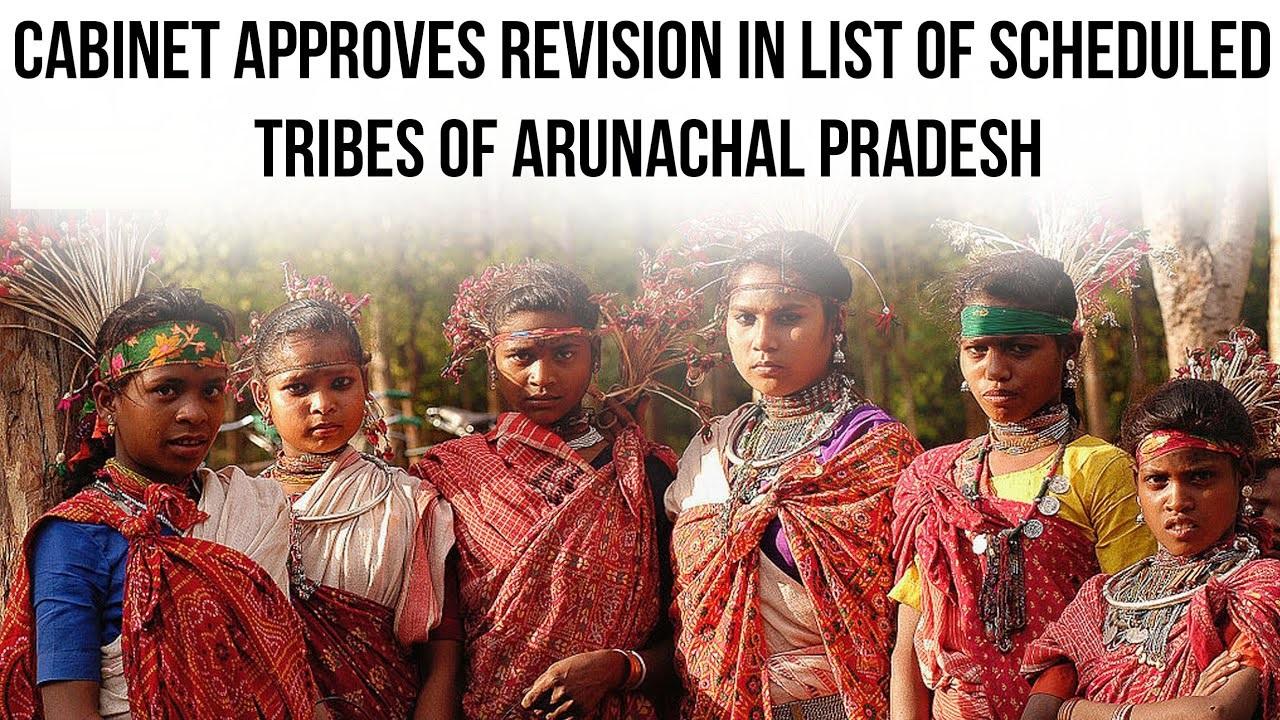Table of Contents
Why in News?
- The Union Cabinet has approved the introduction of an amendment bill namely in the Constitution (Scheduled Tribes) Order, 1950 so as to modify the list of Scheduled Tribes (STs) of Arunachal Pradesh.
Changes will be made in list of STs of Arunachal Pradesh
- Deletion of ‘Abor’ in serial No. 1, as it is the same as ‘Adi’ in Serial No.16.
- Replace ‘Tai Khamti’ instead of ‘Khampti’ at serial No.6
- Inclusion of ‘Mishmi-Kaman’ (Miju Mishmi), Idu (Mishmi) and Taraon (Digaru Mishmi) in serial No. 8
- Inclusion of Monpa, Memba, Sartang, Sajolong (Miji) in serial No. 9 in lieu of ‘Momba’.
- Inclusion of ‘Nocte’, “Tangsa’, Tutsa’, ‘Wancho’ in lieu of ‘Any Naga Tribes’ in serial No. 10 in list of Scheduled Tribes of Arunachal Pradesh
Rationale behind the proposed Amendments
- Deletion of Abor – Removal of duplication
- Replace Khampti – There is no tribe called ‘Khampti’
- Inclusion of Mishmi-Kaman, Idu and Taraon – Existing entry is only of ‘Mishmi’. There is reportedly no such community.
- Inclusion of Monpa, Memba, Sartang, Wancho – Existing entry is of ‘Any Naga Tribes’. These are reportedly the only Naga tribes in the State.
- Inclusion of Nocte, Tangsa, Tutsa, Wancho – Existing entry is of ‘Any Naga Tribes’. These are reportedly the only Naga tribes in the State
- However, the proposed bill does not mention the name of Yobin tribe of Vijaynagar who have been deprived of their ST status. First, the tribe was stripped of their ST status, which was later restored. However, due to technical errors, they are yet to get back their ST status.
Procedure to amend the ST list
- Under the article 342 (1) of the Constitution of India, the President of India was empowered to specify, the castes, races, tribes or parts of groups within castes or races, which shall be deemed to be Scheduled Tribes in relation to that State or Union territory. Thereafter to amend the ST list, a law must be passed by the Parliament
Significance
- After the Bill becomes an Act, member of the communities newly listed in the revised list of Scheduled Tribes of Arunachal Pradesh will also be able to derive benefits meant for STs under the existing schemes of the Government
- Some of the major schemes of this kind include Post Matric Scholarship, National Overseas Scholarship, National Fellowship, Top Class Education, Concessional Loans from National Scheduled Tribes Finance and Development Corporation, Hostels for ST boys and girls etc. •
- They will also be entitled to benefits of reservation in services and admission to educational institutions as per Government policy.
Major Tribes in India: Arranged State-wise
- Andhra Pradesh: Andh, Sadhu Andh, Bhagata, Bhil, Chenchus (Chenchawar), Gadabas, Gond, Goundu, Jatapus, Kammara, Kattunayakan, Kolawar, Kolam, Konda, Manna Dhora, Pardhan, Rona, Savaras, Dabba Yerukula, Nakkala, Dhulia, Thoti, Sugalis.
- Arunachal Pradesh: Apatanis, Abor, Dafla, Galong, Momba, Sherdukpen, Singpho.
- Assam: Chakma, Chutiya, Dimasa, Hajong, Garos, Khasis, Gangte
- Bihar: Asur, Baiga, Birhor, Birjia, Chero, Gond, Parhaiya, Santhals, Savar
- Chhattisgarh: Agariya, Bhaina, Bhattra, Biar, Khond, Mawasi, Nagasia
- Goa: Dhodia, Dubia, Naikda, Siddi,Varl
- Gujarat: Barda, Bamcha, Bhil, Charan, Dhodia, Gamta, Paradhi, Patelia
- Himachal Pradesh: Gaddis, Gujjars, Khas, Lamba, Lahaulas, Pangwala, Swangla
- Jammu and Kashmir: Bakarwal, Balti, Beda, Gaddi, Garra, Mon, Purigpa, Sippi
- C8. • Jharkhand: Birhors, Bhumij, Gonds, Kharia, Mundas, Santhals, Savar.
- Karnataka: Adiyan, Barda, Gond, Bhil, Iruliga, Koraga, Patelia, Yerava.
- Kerala: Adiyan, Arandan, Eravallan, Kurumbas, Malai arayan, Moplahs, Uralis.
- Madhya Pradesh: Baigas, Bhils, Bharia, Birhors, Gonds,Katkari, kharia, Khond, Kol, Murias.
- Maharashtra: Bhaina, Bhunjia, Dhodia, Katkari, Khond, Rathawa, Warlis. • Manipur: Aimol, Angami, Chiru, Kuki, Maram, Monsang, Paite, Purum, Thadou.
- Meghalaya: Chakma, Garos, Hajong, Jaintias Khasis, Lakher, Pawai, Raba.
- Mizoram: Chakma, Dimasa, Khasi, Kuki, Lakher, Pawai, Raba, Synteng.
- Nagaland: Angami, Garo, Kachari, Kuki, Mikir, Nagas, Sema.
- Odisha: Gadaba, Ghara, Kharia, Khond, Matya, Oraons, Rajuar, Santhals.
- Rajasthan: Bhils, Damaria, Dhanka, Meenas(Minas), Patelia, Sahariya.
- Sikkim: Bhutia, Khas, Lepchas.
- Tamil Nadu: Adiyan, Aranadan, Eravallan, Irular, Kadar, Kanikar, Kotas, Todas.
- Telangana: Chenchus.
- Tripura: Bhil, Bhutia, Chaimal, Chakma, Halam, Khasia, Lushai, Mizel, Namte.
- Uttarakhand: Bhotias, Buksa, Jannsari, Khas, Raji, Tharu.
- Uttar Pradesh: Bhotia, Buksa, Jaunsari, Kol, Raji, Tharu.
- West Bengal: Asur, Khond, Hajong, Ho, Parhaiya, Rabha, Santhals, Savar.
- Andaman and Nicobar: Oraons, Onges, Sentinelese, Shompens. • Little Andaman: Jarawa.
- North-East: Abhors, Chang, Galaong, Mishimi, Singpho, Wancho.
Points to remember
-
- Total population of Scheduled Tribes is 84,326,240 as per the Census 2001 which accounts for 8.2% of the total population of country. The share of the Scheduled Tribe population in urban areas is a meager 2.4%. • Madhya Pradesh, Maharastra, Orissa, Gujarat, Rajasthan, Jharkhand, Chhattisgarh, Andhra Pradesh, West Bengal, and Karnataka are the State having larger number of Scheduled Tribes
- These states account for 83.2% of the total Scheduled Tribe population of the country. Assam, Meghalaya, Nagaland, Jammu & Kashmir, Tripura, Mizoram, Bihar, Manipur, Arunachal Pradesh, and Tamil Nadu, account for another 15.3% of the total Scheduled Tribe population. The share of the remaining states / Uts is negligible.
- Ministry of Tribal Affairs
- Ministry of Tribal Affairs is responsible for the over all development of the scheduled tribes in India. This Ministry was set up in 1999 after the bifurcation of Ministry of Social Justice and Empowerment with the objective of providing more focused approach on the integrated socio-economic development of the Scheduled Tribes (STs), the most underprivileged of the Indian Society, in a coordinated and planned manner. National Commission for Scheduled Tribes (NCST) The Tribal Sub Plan (TSP) strategy
























 WhatsApp
WhatsApp